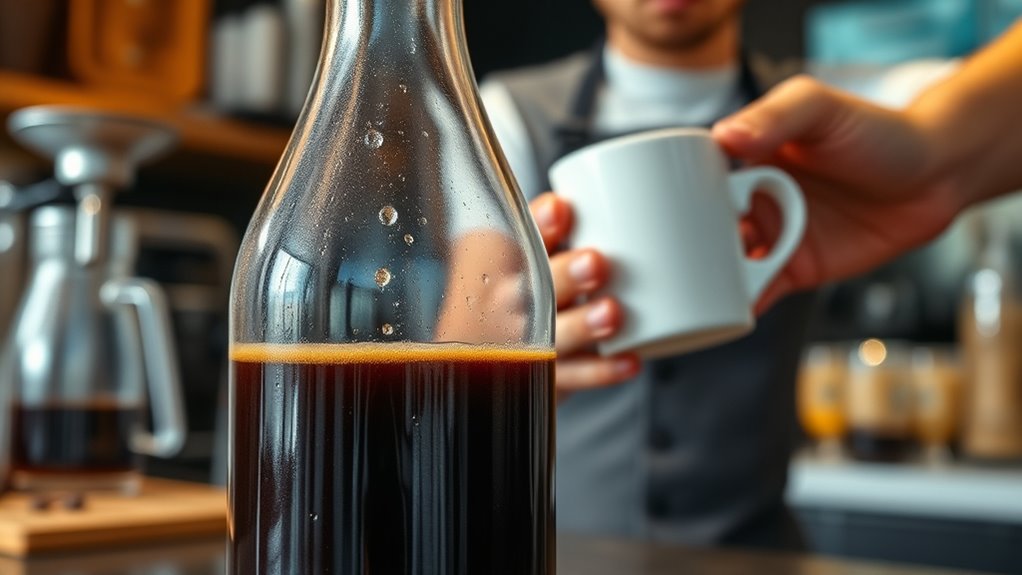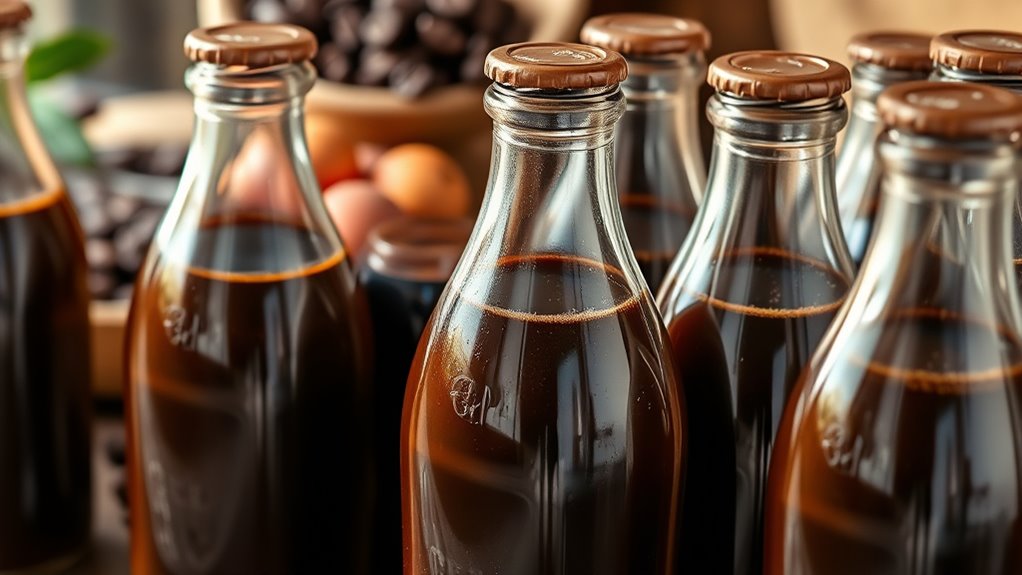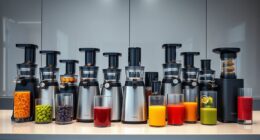Ready-to-drink coffee appeals to busy consumers seeking convenience, portability, and quick caffeine boosts. Market growth is driven by flavor innovation, sustainable sourcing, and eco-friendly packaging, which also attract conscious buyers. Brands that prioritize quality, transparency, and responsible production stand out in this competitive space. Consumer preferences shape industry trends toward sustainability and unique flavors, pushing companies to innovate. If you’re curious about how these factors influence the industry’s future, keep exploring these exciting developments.
Key Takeaways
- Market growth is driven by consumer demand for convenient, portable, and innovative coffee options suitable for busy lifestyles.
- Sustainability concerns influence product development, encouraging eco-friendly sourcing, recyclable packaging, and reduced carbon footprints.
- Flavor innovation and unique blends differentiate brands and enhance consumer experience in the competitive ready-to-drink coffee market.
- Transparency in sourcing, quality assurance, and ethical practices build consumer trust and align with responsible production trends.
- Consumer preferences for sustainability and flavor variety shape industry evolution toward more responsible and innovative ready-to-drink coffee products.

Ready-to-drink coffee has become a popular choice for busy individuals looking for a quick caffeine fix. Its convenience and portability make it an ideal solution for those juggling packed schedules. But as you consider your options, it’s important to recognize the challenges and opportunities shaping this market. One significant issue is sustainability challenges. Many consumers are increasingly concerned about the environmental impact of their coffee choices. From the sourcing of beans to packaging waste, the industry faces pressure to adopt more eco-friendly practices. Brands that prioritize sustainable farming methods, recyclable bottles, and reduced carbon footprints can stand out in a crowded marketplace. As a consumer, your preferences can influence companies to innovate in this space, promoting more responsible production and consumption.
Choosing eco-friendly, sustainably sourced ready-to-drink coffee supports responsible production and reduces environmental impact.
Alongside sustainability challenges, flavor innovation plays a vital role in attracting and retaining customers. The market isn’t just about caffeine anymore; it’s about delivering a sensory experience that keeps you coming back. Coffee companies are experimenting with new flavor combinations, natural additives, and unique brewing techniques to elevate their products. From infused flavors like vanilla and caramel to exotic blends inspired by global coffee traditions, the goal is to offer variety and excitement in a convenient package. When choosing your ready-to-drink coffee, you might find that brands are pushing the boundaries of traditional flavors to appeal to evolving palates. This innovation not only enhances the drinking experience but also helps brands differentiate themselves in a competitive landscape.
However, balancing flavor innovation with quality and sustainability isn’t always straightforward. Some companies might prioritize bold flavors at the expense of organic or ethically sourced ingredients. As someone who values both taste and responsibility, you should look for brands that transparently communicate their sourcing and production practices. Labels indicating fair trade, organic certification, or sustainable packaging can guide you toward choices that align with your values. It’s also worth noting that flavor innovation doesn’t have to compromise quality—many brands are now investing in better extraction and formulation techniques to guarantee consistent, high-quality taste in every bottle. Additionally, the importance of color accuracy in product presentation can influence consumer perception of quality and appeal.
Ultimately, your preferences as a consumer can influence how the ready-to-drink coffee market evolves. By supporting brands that address sustainability challenges and invest in flavor innovation, you contribute to a more responsible and exciting industry. The next time you reach for a coffee on the go, think about the story behind it, the effort to innovate flavor profiles, and the steps toward more sustainable practices. Your choices have the power to shape the future of ready-to-drink coffee, encouraging brands to prioritize both quality and responsibility.
Frequently Asked Questions
What Are the Most Popular Flavors in Ready-To-Drink Coffee?
You’ll find that vanilla, caramel, and mocha top the list of popular flavors in ready-to-drink coffee, as flavor innovations continue to attract consumers. You prefer these familiar tastes because they align with your preferences for smooth, sweet, and indulgent experiences. Manufacturers constantly adapt to consumer preferences, offering a variety of options that cater to your desire for both classic flavors and exciting new blends, ensuring there’s something for everyone.
How Do Shelf Life and Storage Conditions Affect Product Quality?
Shelf life and storage conditions directly impact your ready-to-drink coffee’s quality. Poor storage can compromise shelf stability, causing flavor loss, spoilage, or fermentation. To maintain freshness, you should optimize storage by keeping products in cool, dark places and sealing containers tightly. Proper storage minimizes oxidation and microbial growth, extending shelf life. This ensures your coffee remains flavorful, safe, and appealing for a longer period.
What Are the Environmental Impacts of Packaging Materials Used?
Think of packaging materials as the eco-friendly armor for your coffee. Recyclable packaging reduces landfill waste, while biodegradable materials break down naturally, minimizing pollution. For example, switching to these options can cut plastic waste by up to 50%. Your choice directly impacts the environment, helping conserve resources and lower your carbon footprint. Embracing eco-conscious packaging isn’t just good for the planet—it’s a smart move for your brand’s reputation.
How Does Ready-To-Drink Coffee Compare Nutritionally to Brewed Coffee?
You’ll find that ready-to-drink coffee generally has similar nutritional content to brewed coffee, mainly providing caffeine and antioxidants. However, it often contains added sugars, preservatives, or flavorings, which can impact your health. Nutritional differences may include higher calorie counts or added ingredients, influencing health implications. Always check labels to understand what you’re consuming and choose options that align with your dietary goals for better health.
What Are Emerging Trends Influencing Future Product Development?
Imagine you’re steering a ship through new waters—you’ll want to stay ahead of emerging trends. Innovative brewing methods, like cold brew and nitro coffee, are shaping future products, offering unique flavors and experiences. Meanwhile, sustainable sourcing becomes your compass, ensuring eco-friendly practices appeal to conscious consumers. By combining these trends, you’ll develop products that stand out and align with evolving market demands, guiding your brand to success in the competitive ready-to-drink coffee landscape.
Conclusion
So, next time you clutch that sleek RTD coffee, remember you’re not just fueling your day—you’re part of a billion-dollar circus chasing fleeting caffeine highs. The market’s booming, but at what cost? Quality often takes a backseat to slick packaging and flashy flavors. If you’re okay with sacrificing authenticity for convenience, keep sipping. But maybe, just maybe, true coffee lovers will someday demand more than just a caffeine fix wrapped in shiny plastic.









